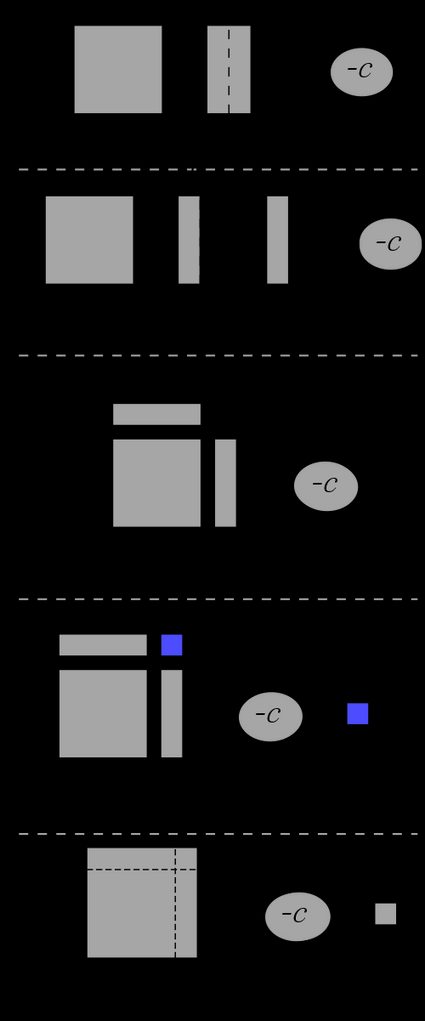Completing the Square Calculator
This calculator for completing the square solves any given quadratic equation in the form ax² + bx + c = 0 with help from the method known as... "completing the square" 😉 Below, we give a detailed example of how to complete the square and then explain geometrically the steps of completing the square.
As a by-product, we will also derive the well-known quadratic formula (used in our quadratic formula calculator), and if by completing the square you mean filling a square with numbers, why not try our magic square calculator?
How does this completing the square calculator work?
You just need to enter the coefficients of the quadratic equation:
ax² + bx + c = 0
...you want to solve. Remember that a can't be zero (otherwise, your equation is linear instead of quadratic).
Our completing the square calculator not only solves the equation but also shows you the steps of how to complete the square.
Go to the Complex number mode and Precision options of this completing the square calculator if you want to:
- Allow complex roots, i.e., equation roots represented by complex numbers (by default, only real roots are displayed).
- Increase the precision with which non-integer coefficients are computed.
How do you complete the square: a step-by-step example
Let's take the equation
x² + 6x - 7 = 0
and solve it by completing the square. We break the process into several simple steps so that nobody gets overwhelmed by the formula for completing the square:
-
Add
7to either side of the equation so that the left-hand side contains only terms withx:x² + 6x - 7 + 7 = 7
x² + 6x = 7 -
Now it's time to complete the square! Take one-half of the coefficient in front of
xand square it:-
the coefficient in front of
xis6 -
one half of
6is3 -
after squaring, we get
3² = 9
-
-
Add the number computed in Step 2 to both sides of the equation:
x² + 6x + 9 = 7 + 9
x² + 6x + 9 = 16 -
Recall the short multiplication formula,
(p + q)² = p² + 2pq + q², and note that we may apply it 'backwards' to the left-hand side of our equation (withp = xandq = 3). We obtain:(x + 3)² = 16 -
Take the calculate the square root:
x + 3 = 4orx + 3 = - 4which gives:
x = 1; andx = - 7
Hence, we've found the solutions of x² + 6x - 7 = 0.
This means we've determined the points where the parabola y = x² + 6x - 7 intersects the x-axis.
Special cases
-
What if
a ≠ 1?In the example above, it is important that the coefficient in front of
x²is equal to1. What do you do if you are asked to solve a quadratic equation wherea ≠ 1? Just apply one of the most frequently used problem-solving techniques in math, namely... transform the problem to some you've already solved🙃 What does that mean in our context? Just divide your equation bya!For example: assume we have to solve
2x² + 12x - 5 = 0by completing the square. We see that
a = 2. Dividing either side by2, we obtainx² + 6x - 2.5 = 0and so the coefficient in front of
x²is equal to1. Now just go ahead with the steps we explained in the example above. -
What if
b = 0?If
b=0, then you may skip Steps 2, 3, and 4 and go fromx² = -c(Step 1) directly tox = ±√|c|(Step 5).Why?
Because in Step 2, we take
band perform some arithmetic operations on it, which gives us the number with which we will 'complete the square.'
Note that ifb = 0, then(b/2)² = 0, and so we would add0to both sides of the equations. This is, of course, redundant.
Quadratic formula via completing the square
Let's go once again through the steps for completing the square. This time we apply it to the general equation
x² + bx + c = 0
-
Note that we've already made sure that
a = 1 -
Move
cto the right-hand side:x² + bx = -c -
x²is the area of the square with sidex -
bxis the area of the rectangle of sidesxandb -
Let the magic happen:

As a consequence, we have
(x + b/2)² = -c + b²/4
Taking the square root and moving b/2 to the right-hand side, we get:
-
x = -b/2 ± √(-c + b²/4)ifb²/4 > c; in such a case, the equation has two distinct real roots. -
x = -b/2ifb²/4 = c: the equation has one real root. -
the equation has no real roots if
b²/4 < c. If we allow complex roots, they are given byx = -b/2 ± i √(c - b²/4).